This was published 8 years ago
Maboneng Project, South Africa: Johannesburg's neighbourhood of cool
An entrepreneurial spirit buzzing away in the heart of Maboneng is bringing arts, culture and life back into a section of Johannesburg's CBD.
By Peter Munro
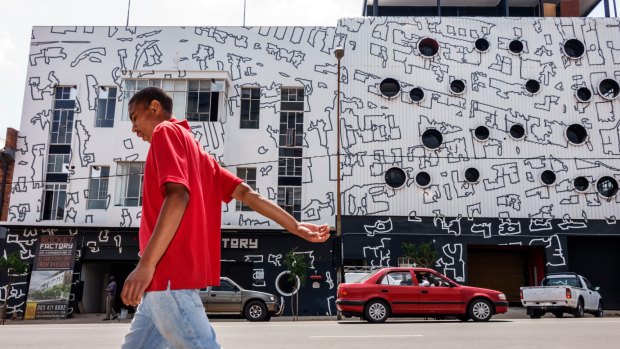
The exterior of the Rocket Factory residential building which was decorated as part of Johannesburg's Maboneng District gentrification programme.Credit: Alamy
Every taxi driver in Johannesburg has a tale to tell about rough rides and bloody run-ins. One tells me his brother was stopped by two men masquerading as police, who jammed a pistol in his face and advised him to exit the vehicle. Another driver tells me some locals won't stop at night at traffic lights (or robots, as they're called here) for fear of being carjacked. But then, his friend was stabbed to death standing at his own front door one Sunday morning. "I still don't know why," he says, quietly.
He stops the taxi outside my hotel and wishes me well. "You too", I say, as he locks his doors and drives away. By now, I'm already well aware of this city's reputation. When I say I'm visiting Johannesburg, people tell me to "take care" and "be safe", soon followed by: "Why don't you go to Cape Town instead?"
But the place where I'm staying reveals a new side to South Africa's largest and much-maligned city. The footpaths are free of rubbish in Maboneng Precinct, an urban renewal project on the eastern fringe of the CBD. Dilapidated buildings have been turned into hip apartments, art galleries, restaurants and roof-top bars. Boutique shops have opened in converted shipping containers. Bright graffiti on the brick walls was commissioned and paid for by property developers.
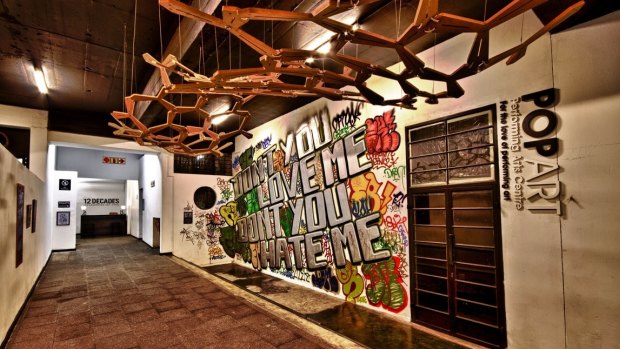
12 Decades Pop Art performing Arts Centre.
The name Maboneng means "place of light", which is odd because it's the most shaded section of Johannesburg's CBD. Standing under ornamental olive trees at a bolthole vodka bar are 20-somethings listening to Van Halen while drinking cheap cocktails, craft beers and white wine in glasses filled with ice cubes. The arrival of four men dressed in all white, like a Boyz II Men cover band, sparks an impromptu fashion show among the crowd of bright young things. Hipsters of all colours mix safely on the streets, suggesting the secret to racial harmony is facial hair, meggings and drinking from jam jars.
It all sounds like a lovely mirage in the middle of the big bad city. And it is, in a way. There are private security guards on every street corner in Maboneng, paid for by residents and retailers. I ask one guard where I might safely jog in the city and he maps out a track only three blocks wide, suggesting I run round and round until I'm tired.
Instead, I set out at dawn with William, who I meet at a cafe when he randomly hands me his phone and asks me to photograph his athletic aqua shortie-shorts and sneakers. As we head east beyond Maboneng, the streets become dirtier and front fences are topped with barbed wire. We run along the roadside, skipping over empty beer bottles.
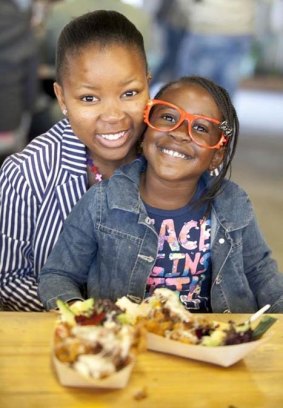
Visitors to the Neighbourgoods Market, Braamfontein in Johannesburg.
William grew up in Johannesburg and recently moved to Maboneng after working for pharmaceutical companies in Zurich and Boston. I ask him what makes this city so special. "It's the American dream," he says. "People come here from all over South Africa wanting to be rich and famous. You can make it here. You have to work hard and be smart and creative. But you can make it here."
That entrepreneurial spirit buzzes at the heart of Maboneng. The rejuvenated precinct is the brainchild of property developer Jonathan Liebmann, who began buying up abandoned buildings here in 2008. A year later, he turned a former liquor warehouse into Arts on Main, a multi-purpose centre for artists, designers and retailers. His company, Propertuity, now owns about 40 buildings in the area, more than half of which are being redeveloped.
We meet at the official opening of Common Ground, a communal park with playground equipment that is surrounded by food stalls and a small primary school. Liebmann is dressed like he's come from a country club, with swept-back hair, a white linen shirt and blue striped shorts.
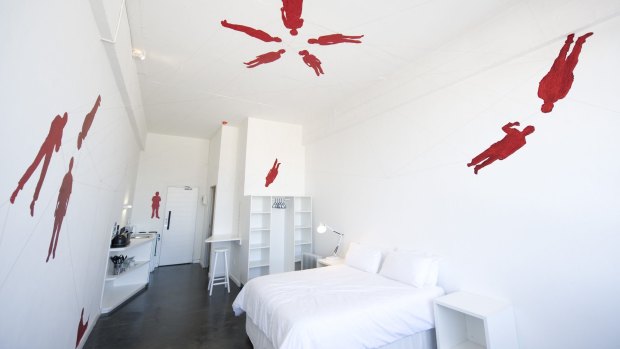
A room at 12 Decades.
He tells me he wanted to bring people back into Johannesburg's CBD to live and play. "The idea is really just to create a cool urban neighbourhood," he says. "I'm an urbanist. I like cities. When I walk the streets I like to ride bicycles."
Propertuity's projects include the 12 Decades Art Hotel, where each room was designed by a local artist to represent a different decade in the modern history of Johannesburg. My room is titled "Vision - Main Street Life" and was co-designed by Liebmann along with artist Marcus Neustetter. The room is narrow and bright white, with a giant wall mural representing a meteor strike south of the city, a tennis umpire's chair in a corner and a terribly uncomfortable bed.
I mention the chair to Liebmann and he suggests I sit on top and look long and hard out the window at the city. So I sit there at sunset and watch as Johannesburg comes into strange focus, looking brown and grey and bright and gold.
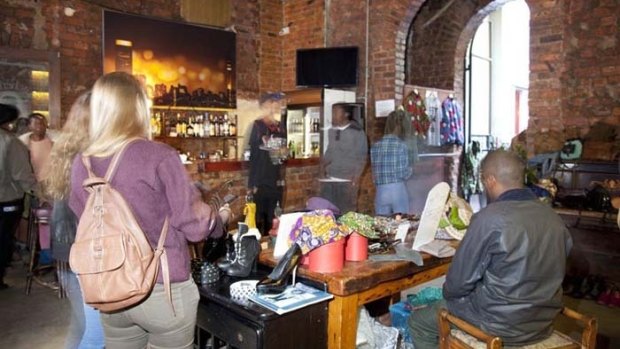
A vendor at the Neighbourgoods Market, Braamfontein.
The next day I stand atop a neighbouring building during a walking tour of the inner city. Tour guide Bonny Mnyandu, who's wearing a big black cap, long shorts and sparkly shoes, points out an abandoned motor mechanics that will be converted soon into an organic supermarket. Other empty buildings are to be reborn as theatres and Argentine restaurants.
Faded signs for laundromats and furniture shops are all that's left of the businesses that fled the city in the early 1990s, amid the unrest and threat of violence during the demise of the Apartheid regime. Mnyandu hopes the rejuvenation of this area will ripple out across Johannesburg. "If we can get these little parts going, the rest of the city will take notice," he says.
Back on the ground are cafes selling sushi and single-origin coffees. It could be Fitzroy or Surry Hills, but for some glaring differences. The menu on the restaurant outside my hotel boasts zebra burgers and kudu (antelope) burgers. What's zebra taste like, I ask the waiter. "It's smooth. Out of 10 I give it a five." Kudu? "10 out of 10." Beef? "I have had too much beef," he says, patting his paunch.
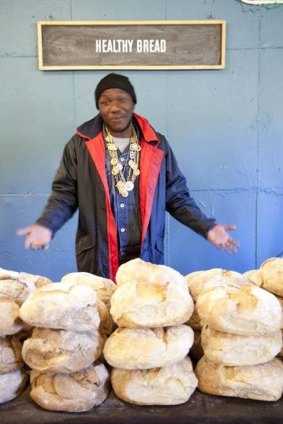
From zebra burgers to shoes, there’s something for all tastes: Neighbourgoods Market, Braamfontein.
The front page of the morning newspaper screams: "Shock twist in axe killings." There's a separate story, with photograph, of a crocodile attacking an elephant. "You come from Australia, it's very peaceful there. Here is f---ing chaos," a local tells me. "That's one thing you can say about Johannesburg: it is never boring."
There's much work left to do here. One block over from Maboneng is a turned-over shopping trolley and five men sitting in the gutter surrounded by booze. National crime rates are rising again after a gradual 20-year decline. Blackouts strike daily as utilities struggle to meet demand. Things are so bad every household and business is sent a schedule of when to expect the next power cut.
"South Africa is one of those countries where you move from one extreme to the next, and there's no middle ground," says tour guide Bonny Mnyandu. "Joburg has a crazy reputation. You could get robbed, you could get killed, you could get eaten. But all these things could happen in any city."
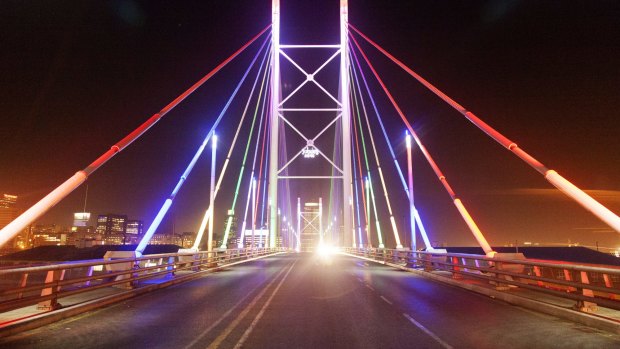
The Nelson Mandela bridge at night.
As I wonder where else I could go to get eaten, we take a minibus from Maboneng through the city centre, past a hundred-metre queue of job-seekers outside a security company. We cross the Nelson Mandela Bridge to the energetic inner-city suburb of Braamfontein, which has also benefited from the big dreams and deep pockets of property developers.
The streets spill over with students from nearby universities, drinking boutique beers or eating house-smoked ribs at a restaurant with knives as big as my thighs. It's lively and a little less showy than Maboneng.
It's Saturday afternoon, when a high-rise concrete carpark is taken over by the weekly Neighbourgoods Market. People walk by drinking alcohol from giant coconuts. Flavours and fragrances collide: chicken and chorizo paella, Belgian waffles with bacon, dim sum, cornish pastries, Argentine chicken, Polish meat and French crepes. The food hails from everywhere in the world, except for much of Africa.
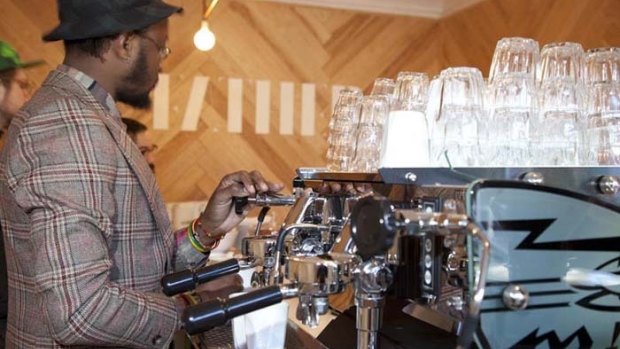
Cappuccino? Neighbourgoods Market, Braamfontein in Johannesburg.
A trio of buskers play drum and bass, and the crowd starts dancing and singing in the streets. How young this city seems. So bleak and then so bright. How old I feel.
"What you have seen today is what we hope to see more of in the future," Mnyandu says, over the sound of music. "Everybody's really getting excited now. People are catching on to the fact that we can't have the city we have had in the past. We need to move away from our dark past."
TRIP NOTES
MORE INFORMATION
GETTING THERE
Major airlines South African Airways (www.flysaa.com), Qantas (www.qantas.com.au), Virgin Australia (www.virginaustralia.com), Emirates (www.emirates.com), Singapore Airlines (www.singaporeair.com) and Cathay Pacific (www.cathaypacific.com) all fly to Johannesburg from Sydney and Melbourne.
STAYING THERE
Maboneng's self-catered 12 Decades Art Hotel, 286 Fox Street, boasts quirky rooms designed by local artists, rooms from $95 a night, see www.urbanhiphotels.com/12-decades. In Braamfontein, The Bannister Hotel, 9 De Beer Street, is affordable and clean, with a lively bar. Rooms from $60 a night, see www.bannisterhotel.co.za.
SEE + DO
Mainstreetwalks runs tours of inner-city Johannesburg, including Maboneng, the traditional healers market and the Newtown cultural precinct. See www.mainstreetwalks.co.za.
The Museum of African Design showcases contemporary work from across the continent. See www.moadjhb.com.
DINING THERE
In Maboneng: House of Baobab, Kruger Street; Uncle Merv's Original Shakes & Coffee, corner Fox and Kruger streets; canteen @ Arts on Main, 286 Fox Street. In Braamfontein: Love Food Kitchen, 4 Ameshoff Street, see www.lovefoodkitchen.com; The Smokehouse and Grill, 73 Juta Street.
The writer was a guest of South African Tourism.
Sign up for the Traveller Deals newsletter
Get exclusive travel deals delivered straight to your inbox. Sign up now.